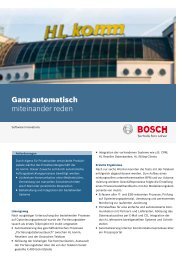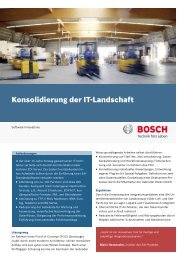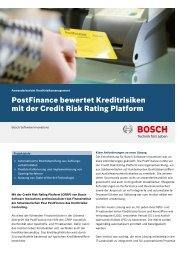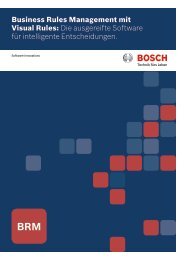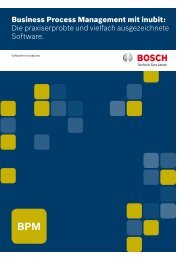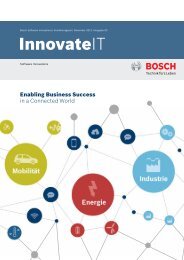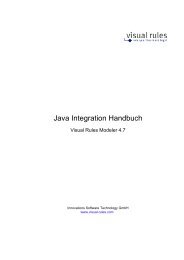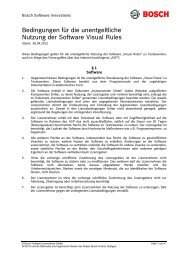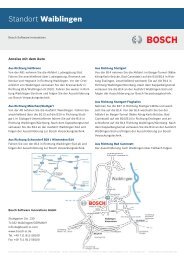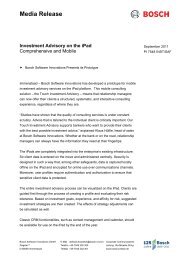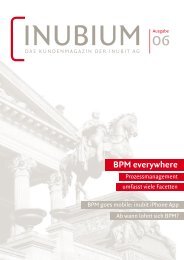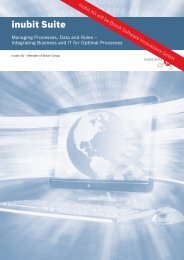Two Reputedly Opposed Approaches: On the Integration of ...
Two Reputedly Opposed Approaches: On the Integration of ...
Two Reputedly Opposed Approaches: On the Integration of ...
Create successful ePaper yourself
Turn your PDF publications into a flip-book with our unique Google optimized e-Paper software.
<strong>Two</strong> <strong>Reputedly</strong> <strong>Opposed</strong> <strong>Approaches</strong>: <strong>On</strong> <strong>the</strong> <strong>Integration</strong> <strong>of</strong> Business Rules and Data Mining<br />
key customers in recent years are tagged with a<br />
"switcher"-flag if <strong>the</strong>y did not order for at least six<br />
months last year and did not order this year so far ei<strong>the</strong>r.<br />
<strong>Two</strong> customer retention experts subsequently<br />
revise <strong>the</strong> data and remove all cases <strong>of</strong> doubt.<br />
Approach: Since several features need to be aggregated<br />
and filtered, business rules are modeled with<br />
Visual Rules (see Figure 2), which<br />
- Remove feature vectors with more than 30%<br />
missing values<br />
- Map some <strong>of</strong> <strong>the</strong> fine-grained features into a<br />
coarser-grained range <strong>of</strong> values<br />
- Decompose some <strong>of</strong> <strong>the</strong> features that merge<br />
several aspects relevant for this scenario<br />
Figure 2: Construction <strong>of</strong> Feature Vectors with a Rule Model<br />
(Extract)<br />
The business rules also convert <strong>the</strong> data into <strong>the</strong> required<br />
format. This data is used to train and evaluate<br />
<strong>the</strong> classification models.<br />
Figure 3: Example Process <strong>of</strong> <strong>the</strong> Classification Task (with<br />
KNIME)<br />
Figure 3 shows <strong>the</strong> essential steps in <strong>the</strong> process: first,<br />
<strong>the</strong> data is read (CSV Reader) and partitioned (Partitioning),<br />
i.e. split into training and test sets. Second,<br />
<strong>the</strong> classification model is calculated based on <strong>the</strong><br />
training set (Naïve Bayes Learner). Third, <strong>the</strong> classification<br />
model is used to predict <strong>the</strong> classes <strong>of</strong> <strong>the</strong> test<br />
set objects (Naïve Bayes Predictor). Finally, <strong>the</strong> classification<br />
model is evaluated (Scorer), i.e. for each object<br />
in <strong>the</strong> test set <strong>the</strong> predicted class is compared with<br />
<strong>the</strong> real one (see box "Popular Evaluation Metrics" for<br />
details).<br />
Let us assume that among <strong>the</strong> best-performing classification<br />
models are a naïve Bayes and a decision tree<br />
classifier. (We use <strong>the</strong>m to simplify matters. Without<br />
doubt, <strong>the</strong>re are more sophisticated algorithms; however,<br />
<strong>the</strong>se two are known to perform well for certain<br />
tasks.)<br />
Popular Evaluation Metrics<br />
The performance <strong>of</strong> a classification algorithm is<br />
measured in terms <strong>of</strong> e.g. precision, recall, and<br />
accuracy given a specific confusion matrix.<br />
with <strong>the</strong> confusion matrix (binary case):<br />
actual<br />
value<br />
predicted value<br />
p' n'<br />
© Bosch S<strong>of</strong>tware Innovations GmbH 4/9<br />
p<br />
n<br />
true<br />
negative<br />
false<br />
negative<br />
false<br />
positive<br />
true<br />
positive<br />
The naïve Bayes is known to be simple and fast – and<br />
despite <strong>the</strong> fact that its simplistic design violates basic<br />
statistical assumptions, it <strong>of</strong>ten performs surprisingly<br />
well for real-world problems. Unfortunately, this classification<br />
model is not self-explanatory and its translation<br />
into business rules is difficult. Instead, if <strong>the</strong> marketing<br />
and sales experts have constructed business rules that<br />
in turn represent a classifier, <strong>the</strong> two models can be<br />
combined. That is to say, <strong>the</strong> naïve Bayes model is<br />
used in <strong>the</strong> manually constructed model, i.e. <strong>the</strong> business<br />
rules, via service call. Combining classification<br />
models can significantly increase <strong>the</strong> predictive performance<br />
<strong>of</strong> <strong>the</strong> ensemble. A comprehensive review <strong>of</strong><br />
possible classifier combination methods, <strong>the</strong>ir advantages,<br />
and disadvantages is given in (Tulyakov,<br />
Jaeger, Govindaraju, & Doermann, 2008).<br />
The decision tree requires little data preparation and<br />
can rapidly classify large data sets. Unfortunately, decision<br />
trees sometimes create models that do not generalize<br />
<strong>the</strong> data (also referred to as overfitting). This<br />
problem can be handled e.g. with pruning mechanisms.<br />
Since decision trees are simple to understand<br />
and interpret (Figure 4 shows <strong>the</strong> extract <strong>of</strong> a decision



